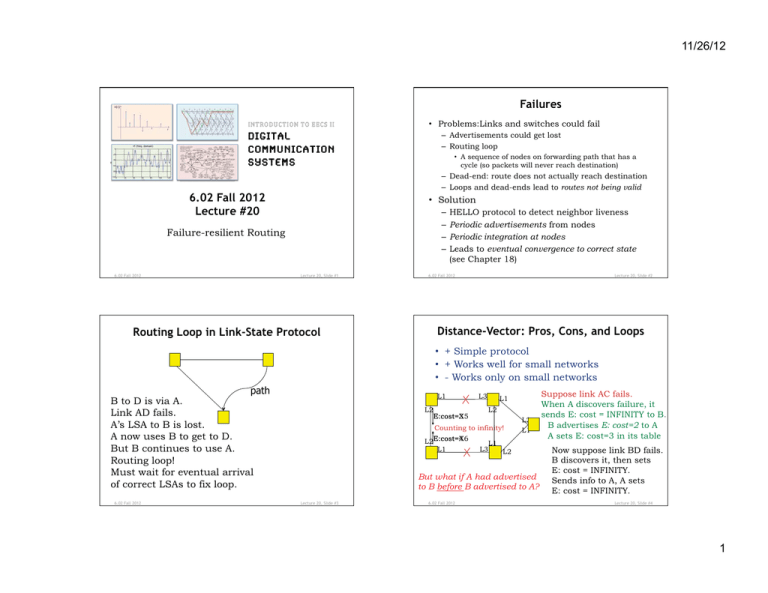11/26/12 F ailures
advertisement

11/26/12 Failures • Problems:Links and switches could fail – Advertisements could get lost – Routing loop • A sequence of nodes on forwarding path that has a cycle (so packets will never reach destination) – Dead-end: route does not actually reach destination – Loops and dead-ends lead to routes not being valid 6.02 Fall 2012 Lecture #20 • Solution – HELLO protocol to detect neighbor liveness – Periodic advertisements from nodes – Periodic integration at nodes – Leads to eventual convergence to correct state (see Chapter 18) Failure-resilient Routing 6.02 Fall 2012 Lecture 20, Slide #1 6.02 Fall 2012 Distance-Vector: Pros, Cons, and Loops Routing Loop in Link-State Protocol A • + Simple protocol • + Works well for small networks • - Works only on small networks B path B to D is via A. Link AD fails. D A’s LSA to B is lost. A now uses B to get to D. But B continues to use A. Routing loop! Must wait for eventual arrival of correct LSAs to fix loop. 6.02 Fall 2012 Lecture 20, Slide #2 A L1 L2 E:cost=X5 E:cost=3 L3 C L1 L2 Counting to infinity! E:cost=X6 L2E:cost=4 L1 B L1 L3 D L2 Suppose link AC fails. When A discovers failure, it sends E: cost = INFINITY to B. L2 E B advertises E: cost=2 to A L1 A sets E: cost=3 in its table But what if A had advertised to B before B advertised to A? Lecture 20, Slide #3 6.02 Fall 2012 Now suppose link BD fails. B discovers it, then sets E: cost = INFINITY. Sends info to A, A sets E: cost = INFINITY. Lecture 20, Slide #4 1 11/26/12 Fixing “Count to Infinity” with Path Vector Routing • In addition to (or instead of) reporting costs, advertise the path discovered incrementally by the Bellman-Ford update rule E: l1; cost=2; path=[CE] [CE] A l1 [ACE] l2 [ACE] [BDE] l2 • Called “path-vector” • Modify Bellman-Ford update with new rule: a node should ignore any advertised route that contains itself in the advertisement 6.02 Fall 2012 Path Vector Routing Lecture 20, Slide #5 [BDE] B l1 E: l2; cost=2; path=[DE] E: l1; cost=1; path=[E] l3 C l1 l2 [CE] [CE] l1 l3 [DE] [DE] [DE] D l2 To reach E, come this way path = [E] l2 l1 E E: Self To reach E, come this way path = [E] E: l2; cost=1; path=[E] • For each advertisement, run integration step – E.g., pick shortest, cheapest, quickest, etc. • Ignore advertisements with own address in path vector – Avoids routing loops that count to infinity 6.02 Fall 2012 Lecture 20, Slide #6 Summary • The network layer implements the “glue” that achieves connectivity – Does addressing, forwarding, and routing • Forwarding entails a routing table lookup; the table is built using routing protocol • DV protocol: distributes route computation; each node advertises its best routes to neighbors – Path-vector: include path, not just cost, in advertisement to avoid “count-to-infinity” • LS protocol: distributes (floods) neighbor information; centralizes route computation using shortest-path algorithm 6.02 Fall 2012 Lecture 20, Slide #7 2 MIT OpenCourseWare http://ocw.mit.edu 6.02 Introduction to EECS II: Digital Communication Systems Fall 2012 For information about citing these materials or our Terms of Use, visit: http://ocw.mit.edu/terms.



